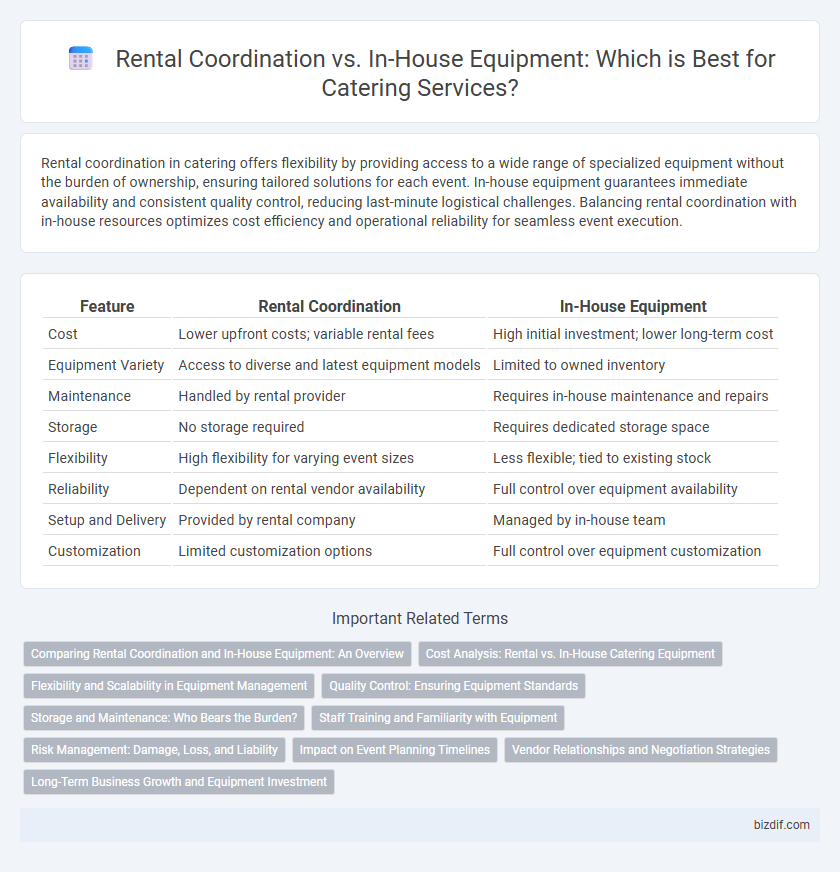Rental coordination in catering offers flexibility by providing access to a wide range of specialized equipment without the burden of ownership, ensuring tailored solutions for each event. In-house equipment guarantees immediate availability and consistent quality control, reducing last-minute logistical challenges. Balancing rental coordination with in-house resources optimizes cost efficiency and operational reliability for seamless event execution.
Table of Comparison
| Feature | Rental Coordination | In-House Equipment |
|---|---|---|
| Cost | Lower upfront costs; variable rental fees | High initial investment; lower long-term cost |
| Equipment Variety | Access to diverse and latest equipment models | Limited to owned inventory |
| Maintenance | Handled by rental provider | Requires in-house maintenance and repairs |
| Storage | No storage required | Requires dedicated storage space |
| Flexibility | High flexibility for varying event sizes | Less flexible; tied to existing stock |
| Reliability | Dependent on rental vendor availability | Full control over equipment availability |
| Setup and Delivery | Provided by rental company | Managed by in-house team |
| Customization | Limited customization options | Full control over equipment customization |
Comparing Rental Coordination and In-House Equipment: An Overview
Rental coordination in catering offers flexibility by providing access to a broad array of specialized equipment tailored for diverse event sizes and themes. In-house equipment ensures consistent quality control and immediate availability, reducing logistical complexities and potential delays. Choosing between rental coordination and in-house equipment depends on event scale, budget constraints, and the need for customization or rapid deployment.
Cost Analysis: Rental vs. In-House Catering Equipment
Rental coordination for catering equipment often reduces upfront capital expenses and maintenance costs, providing flexibility for varied event sizes. In-house equipment requires significant initial investment and ongoing expenses for storage, upkeep, and potential depreciation. Cost analysis reveals rental options can be more economical for occasional or large-scale events, while in-house ownership benefits frequent, consistent usage by spreading fixed costs over time.
Flexibility and Scalability in Equipment Management
Rental coordination in catering offers enhanced flexibility and scalability by allowing event planners to select and adapt equipment based on specific event requirements without long-term investment. In-house equipment management limits scalability due to fixed inventory and requires upfront capital, potentially restricting the ability to accommodate varying event sizes or themes. Leveraging rentals ensures seamless scaling and customization, optimizing resource allocation and operational efficiency in dynamic catering environments.
Quality Control: Ensuring Equipment Standards
Rental coordination in catering often requires stringent quality control protocols to ensure that outsourced equipment meets hygiene and functionality standards, preventing service disruptions. In-house equipment allows direct oversight and routine maintenance, leading to consistently high equipment reliability and compliance with safety regulations. Prioritizing equipment standards through thorough inspections and vendor evaluations strengthens overall event execution and client satisfaction.
Storage and Maintenance: Who Bears the Burden?
Rental coordination shifts the responsibility of storage and maintenance to the equipment provider, reducing overhead costs and space requirements for the catering company. In contrast, in-house equipment demands dedicated storage space and ongoing maintenance efforts, increasing operational complexity and expenses. Efficient rental coordination minimizes equipment downtime and ensures reliability without the long-term burden of upkeep.
Staff Training and Familiarity with Equipment
Staff training is crucial when coordinating rentals versus using in-house equipment, as familiarity with specific tools directly impacts service efficiency and safety. Rental equipment often varies by supplier, requiring staff to adapt quickly to different features and operational methods. In-house equipment allows consistent training protocols, enhancing staff proficiency and reducing the risk of errors during events.
Risk Management: Damage, Loss, and Liability
Rental coordination in catering involves managing external equipment, which increases risks of damage, loss, and liability due to third-party handling. In-house equipment reduces exposure to such risks by maintaining direct control over the condition, maintenance, and usage protocols, minimizing potential incidents. Effective risk management requires detailed insurance coverage and clear contractual agreements when relying on rentals to mitigate financial and operational impacts.
Impact on Event Planning Timelines
Rental coordination often extends event planning timelines due to vendor availability checks, delivery scheduling, and setup coordination, which may introduce unpredictability. In-house equipment streamlines these processes by providing immediate access and control, enabling faster decision-making and reducing lead times. Efficient management of rental logistics or leveraging in-house assets directly influences overall event readiness and timeline accuracy.
Vendor Relationships and Negotiation Strategies
Effective vendor relationships in rental coordination hinge on building trust and maintaining clear communication to secure reliable equipment and favorable terms. In-house equipment management reduces dependency on external vendors but requires investing in maintenance and procurement expertise to optimize cost-efficiency. Strategic negotiation leverages vendor history, volume commitments, and market knowledge to achieve competitive pricing and flexible rental agreements.
Long-Term Business Growth and Equipment Investment
Choosing rental coordination over in-house equipment allows catering businesses to minimize upfront capital expenditures and reduce maintenance costs, facilitating flexible scaling as demand fluctuates. Investing in rental services supports long-term business growth by enabling access to the latest technology without the risk of equipment obsolescence. Strategic equipment investment paired with rental solutions can optimize operational efficiency while preserving cash flow for expansion and marketing initiatives.
rental coordination vs in-house equipment Infographic

 bizdif.com
bizdif.com